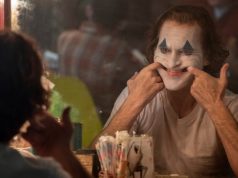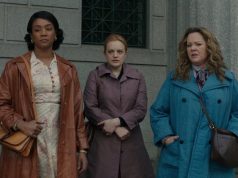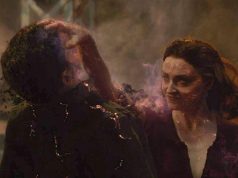If a movie that looked and sounded like “Scott Pilgrim vs. the World” had come out 40 years ago, people would have burned the director at the stake for witchcraft. Even by 2010 standards, the way it’s written, performed, shot, and edited is supremely unusual, an exuberant mixture of comic books, video games, and hipster romance by way of John Hughes. It uses an impressive number of unconventional filmmaking devices, most of which have been done before, but probably not all in the same movie. I bet ten years from now this will be the norm. For now, it’s almost revolutionary.
Based on Bryan Lee O’Malley’s series of graphic novels, this is the story of a 22-year-old Toronto slacker named Scott Pilgrim (Michael Cera) who plays bass in an indie band and is currently “between jobs.” He’s dating a high school student right now, Chinese-Canadian Knives Chau (Ellen Wong), for which he is razzed by his bandmates, his gay roommate Wallace (Kieran Culkin), and his mouthy sister Stacey (Anna Kendrick). Scott, like all Michael Cera characters, flits between meek acceptance of the ridicule and wimpy self-consciousness over it.
Then he meets Ramona Flowers (Mary Elizabeth Winstead), a girl his own age who has just arrived from New York, dazzling him with her ever-changing hair color and general nonchalance. She finds him amusing. If they are to date, however, Scott will have to defeat her seven evil exes, as if he were the hero in a video game.
You see, while the story is set in the real world, it’s a version of the real world in which some of the laws of video games apply. Scott’s confrontations with the exes are staged like rounds of Mortal Kombat. When foes are vanquished, they turn into coins, and the point value appears above them before floating away. It’s not that Scott has to defeat these exes philosophically. He literally has to fight them, both he and they endowed with video-game-like skills.
This is peculiar. More peculiar is that the characters don’t find it peculiar. Scott isn’t astonished at his sudden acquisition of superpowers. He’s nervous about having to fight the exes, but not in a “why are these people trying to kill me?!” kind of way. No one is surprised to see a Nintendo-style battle erupt in the middle of a dance club. This is apparently just how their world works. There’s no sense trying to come up with a logical explanation for why things are this way. Things just are this way.
But I’ve only described the peculiarity of the story. Now let me describe, if I can, how oddly the story is told, by director Edgar Wright (“Shaun of the Dead,” “Hot Fuzz”). Electronic sound effects accompany some of the action, of course, as befits a video-game story aimed at an audience of video-game players. Onscreen titles, like boxes in comic-book panels, introduce new characters. One scene is played out like a sitcom, complete with laugh track. There are sight gags like Scott talking about his shaggy hair, then cutting to someone’s reaction, then immediately cutting back to Scott, who’s now wearing a hat.
We recognize all these quirks as postmodern variations on the way movies normally speak to us. We aren’t meant to believe that there is suddenly a studio audience in Scott’s apartment, or that Scott can put on a hat in a fraction of a second. The usual rules of editing, storytelling, and the expectation of reality — the standard “grammar” of film — are out the window. We’re able to keep up because we know the grammar well enough to appreciate variations on it.
But now I’ve neglected another key element, which is that the movie is very, very funny. In addition to the laughs that arise from the surreal visual style, the screenplay (written by Wright and Michael Bacall) is packed with sharp dialogue that would be funny even in a more traditional setting. On paper, the whole thing isn’t much different from the savvy indie comedies that play at Sundance every year. Imagine one of those, filtered through the brain of someone who grew up devouring comic books and video games, and that’s about what we’ve got.
There’s been a lot of discussion about whether some people are too old to “get” “Scott Pilgrim vs. the World.” I can understand where that idea comes from. I’ll be 36 in a few weeks, and I spent much of the film agape in puzzled wonderment. I laughed plenty, but not as much as the twentysomethings in the audience did. Many of the gags struck me as baffling — pleasantly so, like a new kind of humor had been discovered — rather than laugh-out-loud funny.
Then again, I was never a hardcore video-gamer, nor have I read the “Scott Pilgrim” graphic novels, so maybe it’s not specifically a generational thing. I was impressed that despite how incredibly imaginative and energetic the film is, it never becomes exhausting. Wright seems perfectly in control of the kooky tricks in his arsenal, never deploying them just for the sake of being weird. The fact that I didn’t suffer from stimulation overload suggests that perhaps I am not too old just yet.
Or maybe I am. You see, for as clever and inventive as the movie’s style is, its lack of traditional “reality” makes it hard for me to feel any emotional investment when the John Hughes moments arrive. In a video game, you never die. Even when you’re out of lives, you can continue. When you think of it that way, the stakes actually aren’t very high at all. There are some aspects of the story that don’t resonate with me, that indeed I don’t “get,” possibly because I’m not fluent enough in the insane language of the film. Maybe a native speaker would feel Scott and Ramona’s story right in the ol’ heartstrings. Or maybe those strings don’t matter anymore, in our brave new world.
B+ (1 hr., 52 min.; )





